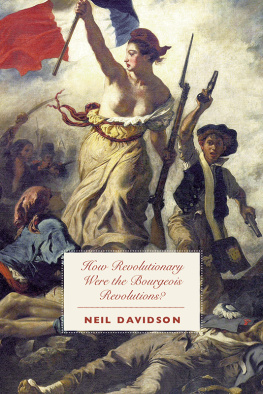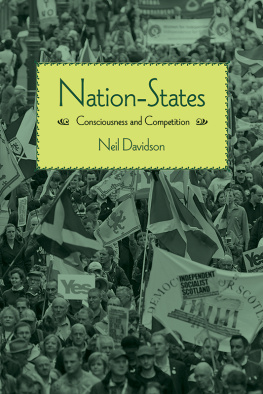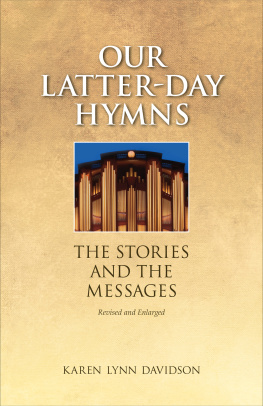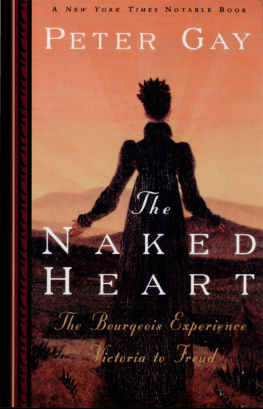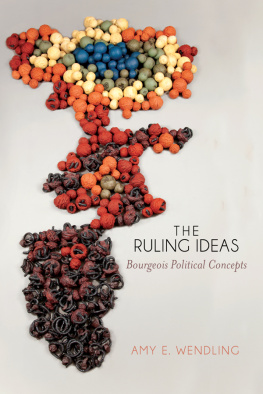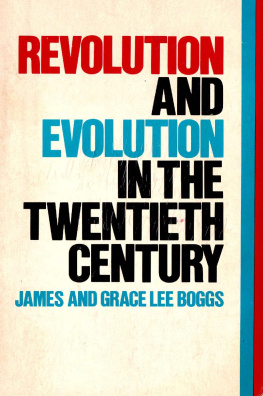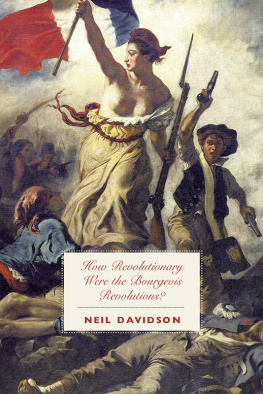Davidson - How Revolutionary Were the Bourgeois Revolutions?
Here you can read online Davidson - How Revolutionary Were the Bourgeois Revolutions? full text of the book (entire story) in english for free. Download pdf and epub, get meaning, cover and reviews about this ebook. City: New York, year: 2012, publisher: Haymarket Books, genre: Politics. Description of the work, (preface) as well as reviews are available. Best literature library LitArk.com created for fans of good reading and offers a wide selection of genres:
Romance novel
Science fiction
Adventure
Detective
Science
History
Home and family
Prose
Art
Politics
Computer
Non-fiction
Religion
Business
Children
Humor
Choose a favorite category and find really read worthwhile books. Enjoy immersion in the world of imagination, feel the emotions of the characters or learn something new for yourself, make an fascinating discovery.
How Revolutionary Were the Bourgeois Revolutions?: summary, description and annotation
We offer to read an annotation, description, summary or preface (depends on what the author of the book "How Revolutionary Were the Bourgeois Revolutions?" wrote himself). If you haven't found the necessary information about the book — write in the comments, we will try to find it.
How Revolutionary Were the Bourgeois Revolutions? — read online for free the complete book (whole text) full work
Below is the text of the book, divided by pages. System saving the place of the last page read, allows you to conveniently read the book "How Revolutionary Were the Bourgeois Revolutions?" online for free, without having to search again every time where you left off. Put a bookmark, and you can go to the page where you finished reading at any time.
Font size:
Interval:
Bookmark:
About the Author

Cathy Watkins
Neil Davidson teaches sociology at the University of Strathclyde and is the author of The Origins of Scottish Nationhood and Discovering the Scottish Revolution for which he was given the Isaac and Tamara Deutscher Memorial Prize and the Andrew Fletcher of Saltoun Award. Davidson also sits on the editorial board of the journal International Socialism .

Francisco Goya, What Courage! from The Disasters of War (18101815)
In memory of Angus Calder (19422008),
Chris Harman (19422009),
and Charles Harrison (19422009): teachers
A Note on the Reproductions
W hat image first comes to mind when we think about the bourgeois revolutions? Most commonly we think of France and the people in the act of insurgency; storming the Bastille perhaps, or mounting a barricade on the streets of Paris. The painting that captures the latter image more effectively than any other is Eugene Delacroixs Liberty Guiding the People (183031), a detail from which is featured on the front cover. Eric Hobsbawm has written of the romantic vision of revolution and the romantic style of being a revolutionary that it embodies: Here saturnine young men in beards and top hats, shirtsleeved workers, tribunes of the people in flowing locks under sombrero-like hats, surrounded by tricolors and Phrygian bonnets, recreate the Revolution of 1793not the moderate one of 1789, but the glory of the Year IIraising its barricades in every city of the continent. The people, after all, are charging toward the likely viewer of the 1830s; the bourgeois habitu of the gallery who would have contemplated the painting from the perspective of the forces of counterrevolution, which may explain its relative unpopularity when first exhibited. But this is not the only ambiguity. Liberty appears to be trampling on the people as much as leading them, which may be suggestive of Delacroixs own ambivalence toward the revolution.
If Delacroixs painting hints at one of the fracture lines of the bourgeois revolution, an earlier work, from the period of the first French Revolution of 17891815, portrays another, darker one. The illustration facing the title page is Francisco Goyas What Courage! The engraving was seventh in a sequence of eighty-five, collectively known as The Disasters of War . The artist produced these in the years leading up to 1820, but they were only published for the first time in 1863, thirty-five years after his death. Like Liberty, his subject fights on a pile of corpses, but this is virtually the only point of comparison with Delacroixs work. Goya certainly depicts a woman; she is not a mythical figure, however, but a historical one called Agustina Zaragoza Domenech, known as Agustina of Aragon for her part in the defense of the regional capital of Zaragoza in 1808. Goya emphasizes not glory but tragedy. Unlike the Scottish painter David Wilkies saccharine version of the same episode, The Defence of Saragoca (1828), Goya does not show us Agustinas face, which is turned toward the enemy, but her back; a solitary figure lighting the fuse of a cannon in a landscape made desolate by war. And who is the enemy? The irony, of course, is that she is defending the city against the French. At home, the Napoleonic armies were the mainstay of an imperial dictatorship; abroad, they imposed the bourgeois revolution from above on the point of their bayonets. But in Spain at least, they were welcomed only by a relatively wealthy, politically liberal minority of the population; the majority rose against the invaders and their local supporters under the banner of church and king. The Disasters of War shows other aspects of the people than those celebrated by Delacroix: ignorant, bestial, in thrall to superstitionthe best that can be said is that the French had provoked them with atrocities even more savage than those committed in response. But this is not all they show. No genuinely popular risingas this one wascan ever be entirely reactionary. What Courage! is not alone among The Disasters of War in portraying the heroism of the Spanish resistance; and most of the others also feature womenAgustinas anonymous sisters. But even the titles convey the ambiguity of Goyas position: The Women Inspire Courage proclaims one, And They Are Like Wild Beasts shudders another.
Despite the very different national contexts from which they sprang, both Delacroixs painting and Goyas engravings are recognizably part of a common bourgeois culture, which in these decades approached the summit of its greatness, and which can still speak to us today. The greatness of bourgeois art did not cease at this point, of course, but it did cease to be directly expressive or representative of the bourgeois worldview. The emergence of the modernist avant-garde in the second half of the nineteenth century may be an inescapable corollary of the consolidation of the bourgeoisie as an actual rather than a potential ruling class, in that its conditions of existence are no longer possible to directly express or represent. Yet despite what appears to be an almost polar opposition, the revolution of Liberty Guiding the People and the counterrevolution of The Disasters of War share one theme in common, which is suspicion of the bourgeoisie. In the case of the French, where a working class had begun to emerge as an independent social force, it is the beginning of a doubt about bourgeois intentions, the dawning realization that the rhetoric of national unity concealed irreconcilable class divisions. In the case of Spain, where the working class had barely begun the process of formation, it is an already firm conviction that the bourgeoisie not only had different economic interests from the popular majoritya liberal is a man with a carriage, as the saying wentbut was also prepared to advance them by betraying the nation to foreign invaders. In the former the bourgeoisie are regarded as being insufficiently opposed to the institution of monarchy; in the latter, of being insufficiently respectful of it. The ambivalence of the bourgeoisie toward the revolutions that bear its name and the contradictions of the bourgeoisie as a revolutionary class, which that relationship reveals, are themes that both these paintings explore in different ways: they are also the subject of this book.
Preface
I t should have come as no surprise that the years of neoliberal ascendancy saw Marxism attacked by the ideologues of a triumphalist bourgeoisie. What is surprising is that these attacks were often given theoretical support by Marxists themselves. Perhaps no other concept in historical materialism came under quite such sustained friendly fire as that of bourgeois revolution, usually on the grounds that the version associated with Stalinism was the only one possible and that intellectual credibility therefore required it to be abandoned. Although the intention of these internal critics was to strengthen Marxism by discarding what they saw as an unnecessary and misleading foreign implantation, their arguments effectively converged with those of earlier anti-Marxists, who more accurately understood what was at stake: the integrity of historical materialism as a coherent intellectual tradition. The title of this book therefore reflects a widespread belief on the left that the bourgeois revolutionsor perhaps we should now describe them as the Events Formerly Known as the Bourgeois Revolutionswere far less significant than had previously been believed. To ask how revolutionary these revolutions were is therefore to ask what type of revolutions they were. In effect, the current consensus has downgraded them from social to political revolutions and it is precisely this reclassification that I want to challenge in what follows. Why? The relevance of this particular Marxist concept, which is concerned with historical events, may not be as immediately obvious as those dealing with, for example, economic crises, which, as we have recently been reminded, are still an inescapable feature of the contemporary world and will remain so as long as capitalism persists. Nevertheless, there are four major reasons why bourgeois revolutions should retain a claim to our attention.
Next pageFont size:
Interval:
Bookmark:
Similar books «How Revolutionary Were the Bourgeois Revolutions?»
Look at similar books to How Revolutionary Were the Bourgeois Revolutions?. We have selected literature similar in name and meaning in the hope of providing readers with more options to find new, interesting, not yet read works.
Discussion, reviews of the book How Revolutionary Were the Bourgeois Revolutions? and just readers' own opinions. Leave your comments, write what you think about the work, its meaning or the main characters. Specify what exactly you liked and what you didn't like, and why you think so.

